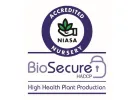 Performing a cost benefit analysis on the implementation of Integrated Pest Management (IPM) in production nurseries is one of the objectives of the levy funded project NY17009. With the project having moved into the second phase, participants are initiating the BioSecure HACCP procedures for ‘Site Surveillance’, ‘Crop Monitoring’, ‘Materials Import Inspections’ and ‘Materials Despatch Inspections’ in their production nurseries.
Performing a cost benefit analysis on the implementation of Integrated Pest Management (IPM) in production nurseries is one of the objectives of the levy funded project NY17009. With the project having moved into the second phase, participants are initiating the BioSecure HACCP procedures for ‘Site Surveillance’, ‘Crop Monitoring’, ‘Materials Import Inspections’ and ‘Materials Despatch Inspections’ in their production nurseries.
Assisting the 7 participating production nurseries by supplying expert advice and implementation assistance of the BioSecure HACCP procedures for structured crop monitoring, GIA has partnered with Biological Services. Lachlan Chilman, Managing Director of Biological Services says he is happy to be a part of the project and is looking forward to the results. The procedure for structured crop monitoring, which is later described in this article, is an integral component of effective IPM. To be done successfully, it requires good knowledge of pests and diseases of the crop, their life cycle, population thresholds, and methods for management. Professional consultants at Biological Services will be using their expertise in these areas to perform crop monitoring for the project and making pest management recommendations to the 7 participating production nurseries.

The principles of effective IPM centre on the management method(s) such as chemical, biological, cultural, physical and variety selection. The BioSecure HACCP procedures employed in this project are the processes used to better inform growers of the pest status, at any given time, within the crop therefore supporting the decision making process when selecting the most appropriate IPM management method.
BioSecure HACCP procedures and how they work to inform and guide a robust IPM strategy improving plant protection and biosecurity in a production nursery:
Crop monitoring is a fundamental element for effective IPM in a production nursery. It requires commitment to a detailed monitoring program performed at a specific frequency relative to the crop type and time of year. Thorough monitoring requires a skilled person performing the task to move randomly, in a ‘Z’ pattern, through the crop, selecting samples of an analogous, or similar, plant type, and inspecting a predetermined number of these (minimum of 35) for signs of pests and diseases. Undertaking this procedure at a known frequency e.g. weekly., for 6 consecutive cycles a grower is statistically likely to detect a pest infestation as low as 5%, well below a damaging threshold. It is important that the individual performing these duties for the production nursery have good knowledge of the pest and disease life cycle as well as population and management thresholds including appropriate IPM options for implementation. Key identification resources such as the Pest ID Tool (www.pestid.com.au) are essential and should be on all mobile phones in the field.
Results along with pest management decisions are then recorded in an organised way so that the crop history is accessible to the grower year after year. This forms a sound knowledge base on which to inform future pest management decisions, particularly, assessing annual forecasting ahead of pest incursions. Regular crop monitoring as described in the BioSecure HACCP crop monitoring procedure allows production nurseries to identify pests, diseases and weeds and manage them before they establish and spread, causing costly damage.

Further plant protection support is offered through the BioSecure HACCP site surveillance and materials import and despatch inspection procedures. These procedures, when implemented correctly, prevent the movement of pests and diseases into and out of the production nursery as well as prevent pest populations establishing in non-cropping areas. This is done through detailed inspections of incoming and outgoing plants, plant parts or propagules, using a statistically sound sampling rate and methods of inspection. Plant pests, diseases and weeds are prevented from entering or leaving the site and evidence of this is recorded. Where necessary consignments found to be infested are returned to suppliers or appropriately treated and re-inspected.
Regular surveillance of the production nursery surrounding areas, as per the site surveillance procedure and site plan, aims to prevent pest, disease and weed establishment across the business site. Through regular and structured pest surveillance of the production nursery non-cropping areas, management of the pest organisms detected is rapid and likely to prevent population build up. Pest populations are managed and prevented from entering the growing areas and infesting the crop therefore preventing damage, death and/or lost markets.
When carried out together, the four BioSecure HACCP procedures delivered by skilled operators forms a solid foundation for effective IPM in production nurseries with businesses reporting 5% or more in productivity gains. Structured crop monitoring and site surveillance allows growers to respond quickly preventing pest, disease, and weed incursions, establishment and spread. Good record keeping provides the ability to forecast future pest and disease emergence, provides a reference of proactive IPM measures, and supports informed management decisions to produce quality high health nursery stock.
For more information:
www.nurseryproductionfms.com.au
www.greenlifeindustry.com.au
